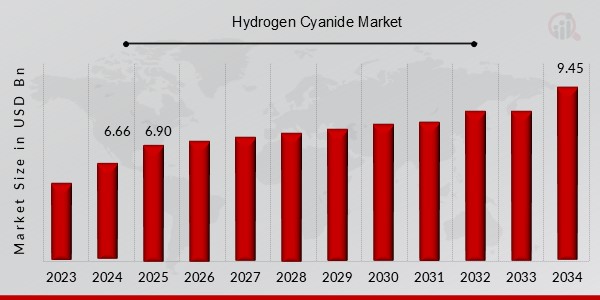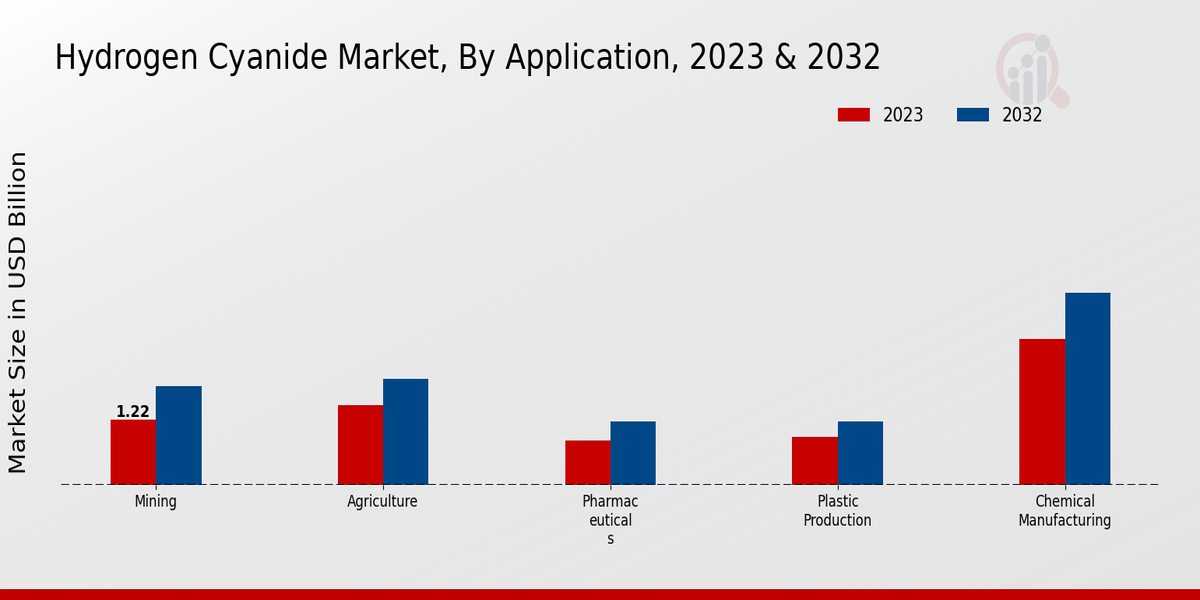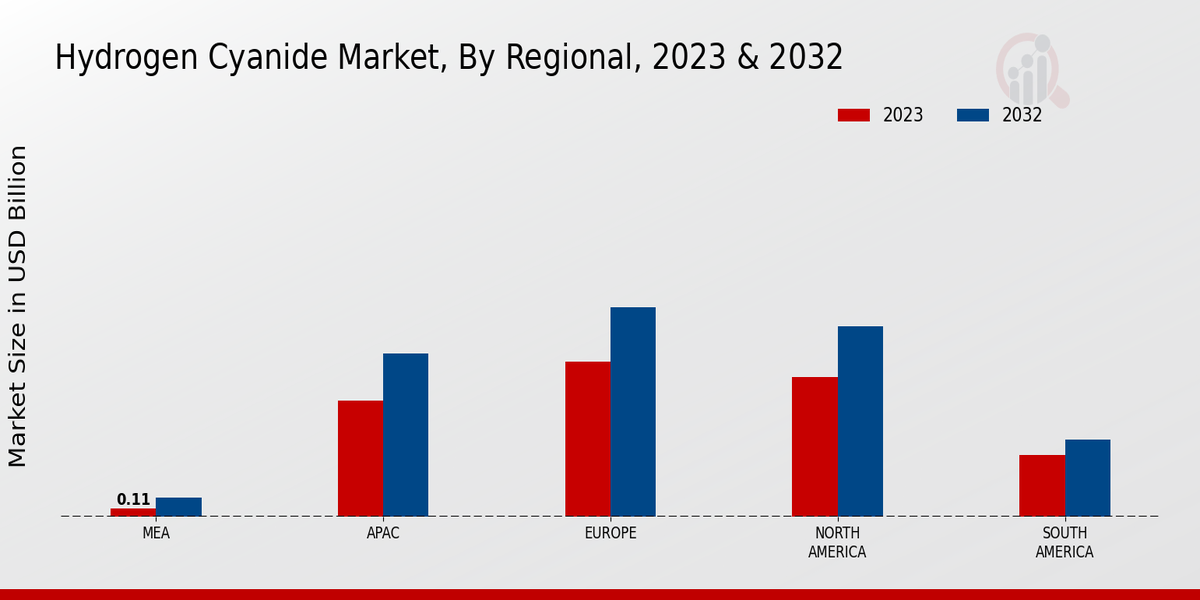Global Hydrogen Cyanide Market Overview
The Hydrogen Cyanide Market Size was estimated at 6.66 (USD Billion) in 2024.The Hydrogen Cyanide Industry is expected to grow from 6.90 (USD Billion) in 2025 to 9.45(USD Billion) by 2034. The Hydrogen Cyanide Market CAGR (growth rate) is expected to be around 3.6% during the forecast period (2025 - 2034).
Key Hydrogen Cyanide Market Trends Highlighted
The Hydrogen Cyanide Market is significantly driven by its extensive use in the production of various chemicals, particularly adjuvants and pesticides, for agriculture. The rising demand for crop protection chemicals, combined with the increase in agricultural practices around the globe, serves as a strong catalyst for market growth. Moreover, the growing need for synthetic fibers and plastics in various industries further propels the consumption of hydrogen cyanide as a precursor. The development of newer, more efficient production methods is also enhancing the supply chain dynamics, ensuring cost-effectiveness and accessibility in the market.Opportunities in the Hydrogen Cyanide Market are ripe for exploration due to the increased focus on sustainable practices and environmental regulations. The market is moving towards greener chemical processes, which can be a significant avenue for innovation and development. The integration of hydrogen cyanide in the production of specialty chemicals and pharmaceuticals presents a noteworthy potential for growth, especially as industries seek to diversify their applications beyond traditional uses. With the ongoing advancements in technology and chemistry, manufacturers could develop more efficient and safer production processes that align with sustainability goals.Recent trends indicate an increasing emphasis on research and development efforts aimed at finding alternatives to hydrogen cyanide, particularly in industries facing strict regulatory pressures. The exploration of bio-based and eco-friendly substitute chemicals is gaining traction, which may influence future consumption patterns. Furthermore, growing awareness of the toxic properties of hydrogen cyanide and its implications on health and safety are prompting industries to improve their operational protocols. As awareness of efficient resource utilization grows, the market is likely to witness a shift towards safer alternatives while optimizing the use of hydrogen cyanide in existing applications.

Source: Primary Research, Secondary Research, MRFR Database and Analyst Review
Hydrogen Cyanide Market Drivers
Increasing Demand from Chemical Manufacturing
The Hydrogen Cyanide Market Industry is significantly driven by the increasing demand from the chemical manufacturing sector. Hydrogen cyanide is a critical intermediate in the production of various chemicals, including plastics, synthetic fibers, and pharmaceuticals. As industries expand and the need for these products grows, the demand for hydrogen cyanide is anticipated to rise correspondingly. The manufacturing of acrylonitrile, which is derived from hydrogen cyanide, continues to see strong growth due to applications in fiber production and plastics.Given that the overall market is expected to grow in value in the coming years, the chemical industry, which requires a reliable supply of hydrogen cyanide, is a primary driver propelling this market forward. Furthermore, innovations in production techniques and processes within the chemical industry could enhance the demand for hydrogen cyanide, supporting the overall Hydrogen Cyanide Market Industry growth. As countries develop their industrial capabilities, hydrogen cyanide will remain a key component due to its pivotal role in modern manufacturing.Additionally, the rise of emerging economies and their expanding industrial bases will contribute to the sustained growth in demand for hydrogen cyanide as a vital chemical compound.
Growing Applications in Pharmaceutical Industry
The Hydrogen Cyanide Market Industry is also benefitting from its growing applications within the pharmaceutical industry. Hydrogen cyanide is used as a key precursor in the synthesis of various pharmaceutical compounds. As the pharmaceutical sector continues to evolve and expand, there is a rising need for effective raw materials to create innovative medicines and health-care products. The increasing investments in drug development and biopharmaceuticals are likely to spur the demand for hydrogen cyanide as manufacturers seek efficient and effective raw materials.This trend indicates a strong growth potential for the hydrogen cyanide market, which is vital to meeting the evolving needs of the pharmaceutical marketplace.
Advancements in Safety and Production Processes
Ongoing advancements in safety and production processes within the hydrogen cyanide manufacturing field are playing a pivotal role in driving the market forward. Innovative techniques are enabling manufacturers to produce hydrogen cyanide in a more efficient and safe manner, reducing risks associated with handling this chemical. Enhanced production methods not only help to minimize environmental impact but also lower operational costs, making it economically viable for industries to incorporate hydrogen cyanide into their processes.The focus on safety and sustainability drives the demand for hydrogen cyanide, aligning with initiatives aimed at responsible manufacturing practices.
Hydrogen Cyanide Market Segment Insights
Hydrogen Cyanide Market Application Insights
The Hydrogen Cyanide Market is witnessing notable growth across various applications, with its overall value projected to reach 6.21 USD Billion in 2023 and grow significantly by 2032. Within this market, the Chemical Manufacturing sector emerges as the dominant player, holding a valuation of 2.76 USD Billion in 2023 and expected to expand to 3.63 USD Billion by 2032, reflecting its crucial role in the synthesis of various chemicals. Following closely is the Agriculture sector, valued at 1.5 USD Billion in 2023 and projected to rise to 2.0 USD Billion by 2032. This application is significant as hydrogen cyanide is utilized for its efficacy in pest control through various agricultural chemicals, playing a vital part in ensuring crop yields and food security. In the Mining sector, the market valuation stood at 1.22 USD Billion in 2023, with projections showing growth to 1.87 USD Billion in 2032. The application of hydrogen cyanide in gold extraction processes is critical, demonstrating its importance as a reagent in hydrometallurgical processes. The Pharmaceuticals industry is also a key segment, with a valuation of 0.83 USD Billion in 2023 expected to increase to 1.2 USD Billion in 2032. The compound’s role in the production of pharmaceutical intermediates reinforces its necessity in healthcare solutions. The Plastic Production segment, while relatively smaller, has a valuation of 0.9 USD Billion in 2023 and is projected to increase to 1.2 USD Billion in 2032, indicating its relevance in synthesizing certain polymers. Overall, the Hydrogen Cyanide Market segmentation highlights the diverse applications across various industries, showcasing the compound's essential nature in both manufacturing and production sectors. The sustainable growth across these applications is driven by technological advancements, regulatory frameworks, and rising demands in these sectors, creating substantial opportunities for future market expansion. However, attention must be given to the safety and environmental considerations surrounding hydrogen cyanide use, ensuring that growth does not compromise safety standards. The Hydrogen Cyanide Market data indicates that these application areas not only embody significant revenue potential but also underscore the compound’s integral contribution to modern industries.

Source: Primary Research, Secondary Research, MRFR Database and Analyst Review
Hydrogen Cyanide Market Form Insights
The Hydrogen Cyanide Market, valued at 6.21 USD Billion in 2023, showcases a dynamic segmentation focused on the Form aspect, specifically Liquid and Gas states. The Liquid form dominates a significant share of the market due to its extensive applications in chemical synthesis and the production of various industrial products. The stable characteristics of Liquid form make it preferable for storage and transportation, thus driving its growth. Conversely, the Gas form, while less prevalent, finds critical use in fumigation processes and is valued for its effectiveness and fast action in agricultural applications.The demand for both forms is influenced by broader industry growth trends, including the rise of agrochemicals and specialty chemicals. Market growth is further propelled by the increasing need for efficient chemical processes in various sectors, although challenges such as safety concerns and regulatory hurdles persist. Overall, the Hydrogen Cyanide Market data reveals a diverse landscape where both Liquid and Gas forms play crucial roles in meeting industrial demands. As a result, the market is poised for steady growth, reflected in the Hydrogen Cyanide Market Statistics and trends shaping the industry.
Hydrogen Cyanide Market Production Method Insights
The Hydrogen Cyanide Market has witnessed significant interest in the Production Method segment, driven by its diverse methodologies, which cater to various industrial applications. In 2023, the overall market was valued at 6.21 USD Billion, and this segment is a fundamental component contributing to its growth. Three primary production methods dominate Anderson's Process, Bergius Process, and Sodium Cyanide Method. Anderson's Process is recognized for its efficiency and relatively lower environmental impact, making it a favorable choice among manufacturers.The Bergius Process is essential for producing hydrogen cyanide from methanol and coal, appealing to sectors that prioritize resource flexibility. Meanwhile, the Sodium Cyanide Method shows dominance in the mining industry, primarily for gold extraction, emphasizing its critical role in the demand for hydrogen cyanide. The Hydrogen Cyanide Market data signifies not only the growth in applications but also highlights the technological advancements that are streamlining these production methods. As the market evolves, enhanced production techniques and sustainability considerations are likely to further shape the dynamics within the Hydrogen Cyanide Market industry, presenting opportunities and challenges for the stakeholders involved.
Hydrogen Cyanide Market End-User Industry Insights
The End-User Industry segment of the Hydrogen Cyanide Market plays a vital role in driving growth and shaping market dynamics. In 2023, the market was valued at 6.21 USD Billion, reflecting its significance within various industries. The Textiles sector utilizes hydrogen cyanide for the production of synthetic dyes and fibers, contributing notably to the overall market due to its extensive applications. Meanwhile, the Agricultural Chemicals sector uses it for manufacturing pesticides and herbicides, making it crucial for enhancing crop yields.The Mining and Metallurgy industry also relies on hydrogen cyanide for gold extraction processes, showcasing its importance in resource recovery. In the Automotive segment, hydrogen cyanide is instrumental in producing plastics and synthetic rubber, which are essential for vehicle manufacturing. The diverse applications across these industries contribute to the anticipated growth of the Hydrogen Cyanide Market, with an expected valuation of 8.5 USD Billion by 2032. With a projected CAGR of 3.55 for the years spanning from 2024 to 2032, there are considerable opportunities for expansion.However, challenges related to environmental regulations and safety concerns must be addressed to ensure sustainable growth.
Hydrogen Cyanide Market Distribution Channel Insights
The Hydrogen Cyanide Market revenue reflects a diverse distribution channel landscape, which plays a critical role in the overall market dynamics. As of 2023, the market is projected to be valued at 6.21 billion USD, portraying robust growth. Distribution channels such as Direct Sales, Distributors, and Online Sales significantly influence the accessibility and availability of hydrogen cyanide. Direct Sales are vital as they foster closer client relationships and tailored services. Distributors play an essential role by expanding reach ensuring broader market penetration, especially in regional markets.Online Sales are increasingly important, providing convenience and efficiency to buyers while tapping into a growing digital marketplace. The changing landscape of purchasing behaviors, driven by growing online shopping trends, supports the rise of this channel. Overall, the segmentation of the Hydrogen Cyanide Market data indicates that these distribution methods are crucial for market growth and reaching diverse customer bases. Understanding the intricacies within these channels can provide valuable insights into consumer preferences and market strategies, facilitating easier access to this critical industry resource.
Hydrogen Cyanide Market Regional Insights
The Regional segment of the Hydrogen Cyanide Market reflects a diverse landscape, with Europe leading with a valuation of 2.0 USD Billion in 2023, while the Asia Pacific follows closely at 1.5 USD Billion. North America holds a significant share of 1.8 USD Billion during the same period, showing its relevance in the Hydrogen Cyanide Market revenue. Europe’s dominance can be attributed to its well-established industrial sector and stringent safety regulations driving demand. Meanwhile, Asia Pacific is recognized for its rapid industrialization and population growth, contributing to its notable market share, and indicating its potential growth trajectory.The Middle East and Africa, valued at 0.11 USD Billion, represent the smallest portion of the market, likely due to limited industrial applications. South America holds a valuation of 0.8 USD Billion, indicating a moderate entry into the hydrogen cyanide landscape. Overall, the Hydrogen Cyanide Market segmentation demonstrates varied growth potentials across regions, driven by factors such as industrial demand and regulatory frameworks, establishing opportunities for expansion in less dominant regions.

Source: Primary Research, Secondary Research, MRFR Database and Analyst Review
Hydrogen Cyanide Market Key Players And Competitive Insights
The Hydrogen Cyanide Market is a dynamic sector characterized by significant competitive activity among various players. As an essential chemical, hydrogen cyanide plays a crucial role in multiple industries, including agrochemicals, pharmaceuticals, and plastics. The market is influenced by factors such as regulatory standards, production technologies, and end-user demand, which prompts constant innovation and strategic positioning among key competitors. Understanding the competitive landscape is fundamental for stakeholders aiming to capitalize on growth opportunities, mitigate risks, and navigate the complexities of this market effectively.Dow has established itself as a formidable competitor in the Hydrogen Cyanide Market, leveraging its extensive technological expertise and vast distribution network. The company's strong research and development capabilities allow it to innovate and enhance its product offerings that cater to diverse applications, including the production of agrochemicals and specialty chemicals. Dow's operations are characterized by its commitment to sustainability and adherence to stringent safety standards, thereby reinforcing its reputation as a reliable and responsible producer. The company's strategic alliances and partnerships further augment its market presence, enabling it to respond adeptly to changing market demands and regulatory requirements, thereby solidifying its competitive edge.Yara International holds a noteworthy position in the Hydrogen Cyanide Market, recognized for its leadership in agricultural solutions. The company's focus on producing high-quality hydrogen cyanide primarily serves its core business in nitrogen-based fertilizers, demonstrating a seamless integration of product offerings. Yara International's emphasis on sustainability and innovative farming techniques highlights its commitment to not only meeting market demands but also contributing to food security. The company’s operational excellence, paired with its ability to leverage advanced agricultural research, positions Yara International favorably within the market, allowing it to maintain a competitive stance through optimized product development and strategic market engagements.
Key Companies in the Hydrogen Cyanide Market Include
Hydrogen Cyanide Market Industry Developments
Recent developments in the Hydrogen Cyanide Market have been marked by increased demand across various applications, notably in the chemical, agricultural, and pharmaceutical sectors. Innovations in manufacturing processes and stringent regulations aimed at enhancing safety standards have also been significant. With the market projected to grow steadily, stakeholders are focusing on sustainable production methods to address environmental concerns. Key players are investing in research and development to optimize hydrogen cyanide extraction and improve efficiency. Additionally, geopolitical factors and supply chain dynamics continue to influence market trends. As industries look for reliable sources, collaboration between producers and end-users is becoming essential for maintaining supply stability. Emerging markets are expected to drive growth, with Asia-Pacific leading in consumption due to rising agricultural needs. Therefore, the hydrogen cyanide sector stands at a pivotal point, characterized by opportunities for both growth and innovation while navigating the complexities of regulatory landscapes and trade dynamics.
Hydrogen Cyanide Market Segmentation Insights
Hydrogen Cyanide Market Application Outlook
-
Chemical Manufacturing
-
Mining
-
Agriculture
-
Pharmaceuticals
-
Plastic Production
Hydrogen Cyanide Market Form Outlook
Hydrogen Cyanide Market Production Method Outlook
-
Anderson's Process
-
Bergius Process
-
Sodium Cyanide Method
Hydrogen Cyanide Market End-User Industry Outlook
-
Textiles
-
Agricultural Chemicals
-
Mining and Metallurgy
-
Automotive
Hydrogen Cyanide Market Distribution Channel Outlook
-
Direct Sales
-
Distributors
-
Online Sales
Hydrogen Cyanide Market Regional Outlook
-
North America
-
Europe
-
South America
-
Asia Pacific
-
Middle East and Africa
| Report Attribute/Metric |
Details |
| Market Size 2024 |
6.66 (USD Billion) |
| Market Size 2025 |
6.90 (USD Billion) |
| Market Size 2034 |
9.45 (USD Billion) |
| Compound Annual Growth Rate (CAGR) |
3.6% (2025 - 2034) |
| Report Coverage |
Revenue Forecast, Competitive Landscape, Growth Factors, and Trends |
| Base Year |
2024 |
| Market Forecast Period |
2025 - 2034 |
| Historical Data |
2020 - 2024 |
| Market Forecast Units |
USD Billion |
| Key Companies Profiled |
Dow, Yara International, Gujarat State Fertilizers and Chemicals, Huntsman Corporation, Nantong Jiangshan Chemical, Nouryon, Taekwang Industrial, Cyanamid, Evonik Industries, Sigma-Aldrich, Mitsubishi Gas Chemical, SABIC, BASF, Aditya Birla Chemicals |
| Segments Covered |
Application, Form, Production Method, End-User Industry, Distribution Channel, Regional |
| Key Market Opportunities |
Growing demand in pharmaceuticals Expansion in agrochemical applications Advancements in chemical synthesis Increasing use in the mining industry Rising prominence in energy storage technologies. |
| Key Market Dynamics |
Increasing industrial demand Stringent safety regulations Raw material price fluctuations Advancements in production technology Environmental impact concerns |
| Countries Covered |
North America, Europe, APAC, South America, MEA |
Frequently Asked Questions (FAQ) :
The Hydrogen Cyanide Market is expected to be valued at 9.45 USD Billion by 2034.
The expected CAGR for the Hydrogen Cyanide Market is 3.6 from 2025 to 2034.
The Chemical Manufacturing segment has the highest market value at 2.76 USD Billion in 2023.
The Agriculture segment is expected to grow to 2.0 USD Billion by 2032.
North America is the largest market for Hydrogen Cyanide, valued at 1.8 USD Billion in 2023.
The European Hydrogen Cyanide Market is projected to be valued at 2.7 USD Billion by 2032.
The Mining application segment is forecasted to reach 1.87 USD Billion by 2032.
Major players in the market include Dow, Yara International, and BASF, among others.
The MEA region is expected to reach a value of 0.25 USD Billion by 2032.
The Pharmaceuticals segment is valued at 0.83 USD Billion in 2023.
















